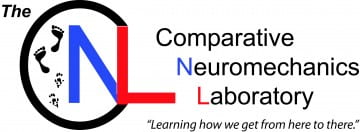Recent Publications
- Selgrade, B.P., Toney, M.E., Chang, Y-H. Changes in mechanical work during locomotor adaptation split-belt treadmill walking in trans-tibial amputees. [In preparation].
- Thajchayapong, M., Cho, G., Selgrade, B.P., Toney, M.E., Chang, Y-H. Changes in mechanical work during locomotor adaptation in split-belt treadmill walking. [In preparation].
- Littrell, M.E., Chang, Y-H., Selgrade, B.P. Development of a low-cost system to analyze kinetics and kinematics of human locomotion. [Under Review].
-
Selgrade BP, Chang YH. Locomotor control of limb force switches from minimal intervention principle in early adaptation to noise reduction in late adaptation. J Neurophysiol. 2015 Mar 1;113(5):1451-61. doi: 10.1152/jn.00246.2014. Epub 2014 Dec 4.
-
Toney ME, Chang YH. Humans robustly adhere to dynamic walking principles by harnessing motor abundance to control forces. Exp Brain Res. 2013 Dec;231(4):433-43. doi: 10.1007/s00221-013-3708-9. Epub 2013 Oct 1.
-
Bauman JM, Chang YH. Rules to limp by: joint compensation conserves limb function after peripheral nerve injury. Biol Lett. 2013 Aug 14;9(5):20130484. doi: 10.1098/rsbl.2013.0484. Print 2013 Oct 23.
-
Auyang AG, Chang YH. Effects of a foot placement constraint on use of motor equivalence during human hopping. PLoS One. 2013 Jul 30;8(7):e69429. doi: 10.1371/journal.pone.0069429. Print 2013.
-
Hochman S, Hayes HB, Speigel I, Chang YH. Force-sensitive afferents recruited during stance encode sensory depression in the contralateral swinging limb during locomotion. Ann N Y Acad Sci. 2013 Mar;1279:103-13. doi: 10.1111/nyas.12055
-
Hochman S, Gozal EA, Hayes HB, Anderson JT, DeWeerth SP, Chang YH. Enabling techniques for in vitro studies on mammalian spinal locomotor mechanisms. Front Biosci (Landmark Ed). 2012 Jun 1;17:2158-80. Review
-
Hayes HB, Chang YH, Hochman S. Stance-phase force on the opposite limb dictates swing-phase afferent presynaptic inhibition during locomotion. J Neurophysiol. 2012 Jun;107(11):3168-80. doi: 10.1152/jn.01134.2011. Epub 2012 Mar 21.
-
Yeom HJ, Selgrade BP, Chang YH, Kim JL. Motor noise removal for determining gait events over treadmill walking using wavelet filter. J Adv Smart Convergence. 2012;1(1):48-51.
-
Been LE, Bauman JM, Petrulis A, Chang YH. X-ray kinematics analysis of vaginal scent marking in female Syrian hamsters (Mesocricetus auratus). Physiol Behav. 2012 Feb 28;105(4):1021-7. doi: 10.1016/j.physbeh.2011.11.007. Epub 2011 Dec 2.
Other Publications
- Yeom, H.J. and Y.-H. Chang. Autogenic EMG-controlled functional electrical stimulation for ankle dorsiflexion control. J. Neuroscience Methods, 193: 118-125, 2010; DOI: 10.1016/j.jneumeth.2010.08.011.

- Yen, J.T. and Y.-H. Chang. Rate-dependent control strategies stabilize limb forces during human locomotion. J. Royal Society Interface, 7: 801-810, 2010; DOI: 10.1098/rsif.2009.0296.

- Bauman, J. and Y.-H. Chang. High-speed X-ray video demonstrates significant skin movement errors with standard optical kinematics during rat locomotion. J. Neuroscience Methods, 186: 18-24, 2010.

- Chang, Y.-H., A. Auyang, J.P. Scholz, and T.R. Nichols. Whole limb kinematics are preferentially conserved over individual joint kinematics after peripheral nerve injury. J. Experimental Biology, 212: 3511-3521, 2009.

- Yen, J.T., A.G. Auyang, and Y.-H. Chang. Joint-level kinetic redundancy is exploited to control limb-level forces during human hopping. Experimental Brain Research, 196: 439-451, 2009.

- Hayes, H.B., Y.-H. Chang, and S. Hochman. An in vitro spinal cord-hindlimb preparation for studying behaviorally relevant rat locomotor function. J. Neurophysiology, 101: 1114-1122, 2009.

- Auyang, A.G., J.T. Yen, and Y.-H. Chang. Neuromechanical stabilization of leg length and orientation through interjoint compensation during human hopping. Experimental Brain Research, 192: 253-264, 2009.

- Chang, Y.-H., Roiz, R.A., and A.G. Auyang. Intralimb compensation strategy depends on the nature of joint perturbation in human hopping. J. Biomechanics, 41(9): 1832-1839, 2008.

- Yeom, H. J., Park, Y.C. and Y.-H. Chang. Eigen filter to detect volitional EMG signals in autogenic EMG-controlled FES. IEEE Electronics Letters, 43(25): 1410-1411, 2007.

- Chang, Y.-H. and R. Kram. Limitations to running speed on flat curves. J. Experimental Biology, 210:971-982, 2007.

- Chang, Y.-H., C.M. Hamerski and R. Kram. Applied horizontal force increases impact loading in reduced gravity running. J. Biomechanics, 34: 679-685, 2001.

- Bertram, J.E.A. and Y.-H. Chang. Mechanical energy oscillations of two brachiation gaits: measurement and simulation. American J. Physical Anthropology, 115: 319-326, 2001.

- Chang, Y.-H., J.E.A. Bertram and D.V. Lee. External forces and torques generated by the brachiating whitehanded gibbon (Hylobates lar). American J. Physical Anthropology, 113: 201-216, 2000.

- Chang, Y.-H., H.-W.C. Huang, C.M. Hamerski and R. Kram. The independent effects of gravity and inertia on running mechanics. J. Experimental Biology, 203: 229-238, 2000.

- Chang, Y.-H. and R. Kram. Metabolic cost of generating horizontal forces during human running. J. Applied Physiology, 86: 1657-1662, 1999.

- Bertram, J.E.A., A. Ruina, C.E. Cannon, Y.-H. Chang and M.J. Coleman. A point-mass model of gibbon locomotion. J. Experimental Biology, 202: 2609-2617, 1999.

- Kram, R., T.M. Griffin, J.M. Donelan and Y.-H. Chang. Force treadmill for measuring vertical and horizontal ground reaction forces. J. Applied Physiology, 85: 764-769, 1998.

- Chang, Y.-H., J.E.A. Bertram and A. Ruina. A dynamic force and moment analysis system for brachiation. J. Experimental Biology, 200: 3013-3020, 1997.

- Schutt, W.A., J.S. Altenbach, Jr., Y.-H. Chang, D.M. Cullinane, J.W. Hermanson, F. Muradali and J.E.A. Bertram. The dynamics of flight-initiating jumps in the common vampire bat (Desmodus rotundus). J. Experimental Biology, 200: 3003-3012, 1997.

Book Chapters
- Chang, Y.-H. Limb compensation strategies for controlling locomotor stability. In: “Advances in Neuromuscular Physiology of Motor Skills and Muscle Fatigue”. ed., M. Shinohara. Invited Book Chapter, 191-213, 2009

- Chang, Y.-H. and S. Latourelle. Simple methods for modeling the physiology of arterial dynamics. In: “Laboratory Manual for Physiology”. D.U. Silverthorn, B.R. Johnson and A.C. Mills (eds.). Benjamin Cummings, San Francisco, p. 93-105, 2005.
Presentations, Posters and Conference Abstracts
- Selgrade, B.P., Toney, M.E., Chang, Y.H. Split-belt treadmill adaptation in trans-tibial amputees. Neuroscience 2015, October, 17, 2015.
- Selgrade, B.P., Chang, Y.H. The control strategy for human locomotor adaptation changes with practice from optimal feedback control to noise reduction. Georgia Tech Bioengineering conference, August 15, 2013.
- Selgrade, B.P., Chang, Y.H. The control strategy for human locomotor adaptation changes with practice from optimal feedback control to noise reduction. International Society of Biomechanics Brazil, August 8, 2013.
- Selgrade, B.P., Chang, Y.H. Adaptation of limb forces to altered visual feedback during human hopping. Neuroscience 2012, October, 14, 2012.

